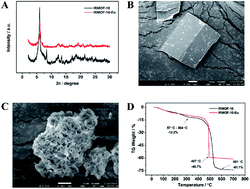A dual emission metal–organic framework for rapid ratiometric fluorescence detection of CO32− in seawater†
Abstract
A dual emission metal–organic framework (IRMOF-10-Eu) was prepared and used as a ratiometric fluorescent sensor for CO32− detection. IRMOF-10-Eu had good stability and excellent luminescence in aqueous solution. IRMOF-10-Eu showed dual fluorescence emission from the ligand and Eu3+ with single excitation. Upon treatment with CO32−, the fluorescence ratio (I624/I358) of the probe displayed significant change. The relative fluorescence intensity ratio (I624/I358) and CO32− concentration had a linear relationship in 50–300 μM range with a low detection limit of 9.58 μM. And the luminescence probe of CO32− showed a fast detection time. The possible mechanism was investigated. CO32− changed the structure of IRMOF-10-Eu and interrupted the energy transfer process. Thus, the fluorescence emission intensity of the ligand was increased and Eu3+ was decreased with the addition of CO32−. IRMOF-10-Eu was used to detect CO32− in seawater, which showed good prospect in practical application. Subsequently, a highly selective and sensitive probe, IRMOF-10-Eu, may pave an efficient way for CO32− detection in seawater.



 Please wait while we load your content...
Please wait while we load your content...